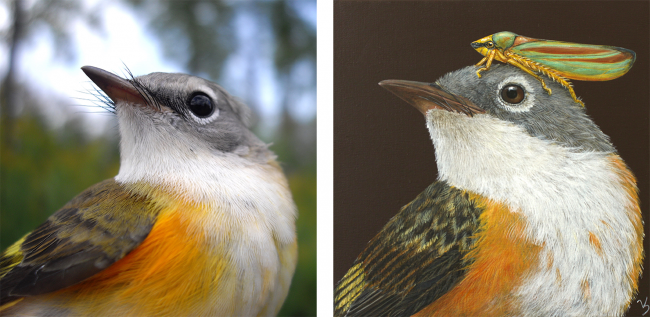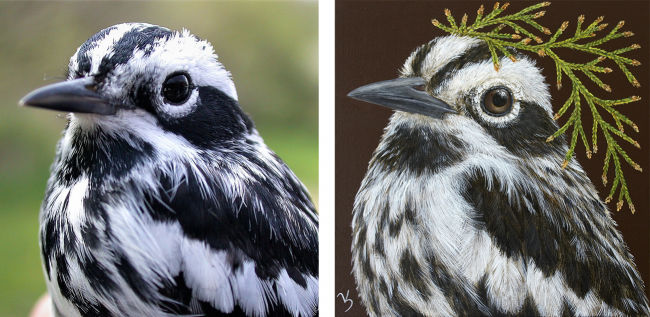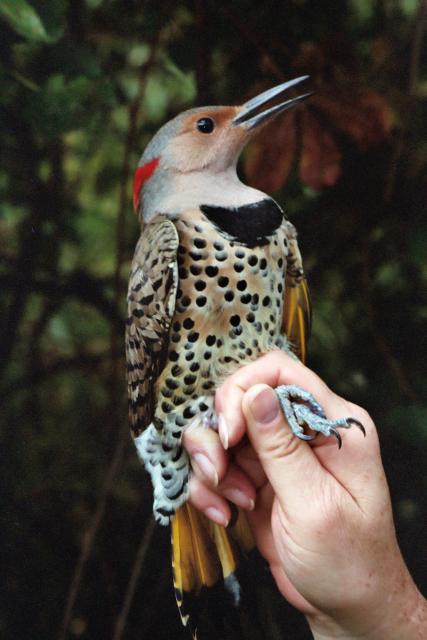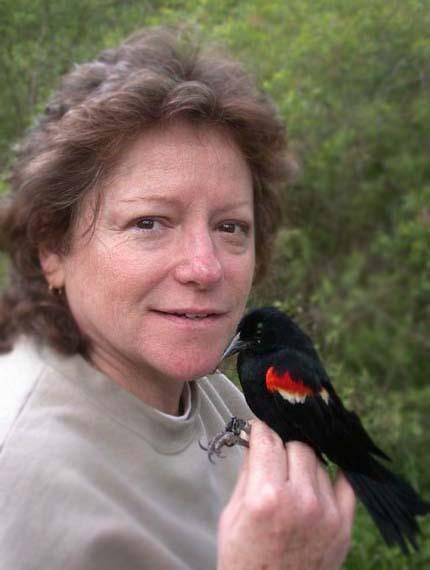Q & A with field ornithologist, Rachel A. Powless

A few months ago, Rachel A. Powless, a field ornithologist who takes detailed photographs of birds while bird banding, graciously invited me to use her photographs for inspiration. I was blown away by the fine detail. I have greatly enjoyed learning so much through Rachel’s vast knowledge of birds which is a testimony of her love for them.
- When did you develop an interest in bird banding and photographing birds?
- It was out of necessity that I became enraptured in photographing birds. The beautiful eyes and the color, texture, and placement of those thousands of feathers were music to my eyes. I am a bird bander first. My love of photographing birds came out of the need to photograph specific regions of a bird to analyze when we got home. By holding the bird in my left hand, in what we refer to as "the photographer's grip," I take a small camera our of my right pocket and begin looking through a lens inches away from the bird. It is always mesmerizing!
- When going out to bird band, what are some of your typical preparations?
- My husband and I have been banding birds (placing individual uniquely numbered aluminum alloy bands on over 110 species of birds) since the late 1990’s. We have been privileged & grateful to band over 10,000 birds. Our permits to do this come from Ottawa, Canada. We live in Port Huron, MI and band in Canada primarily on Native Territories throughout Ontario. The U.S., Canada, and Mexico all have similar protocols in training and in addition to when you receive your permit. Specific data is required to send Ottawa. Eventually, this goes to the U.S. outside of D.C. Our permits have many stipulations as to what birds we can band, how we capture them, etc. We can band songbirds, owls, hawks and hummingbirds. Hummingbirds require a specialized permit. We can band in Canada only.

- What is the process of “catching” the birds to band them?
- By now, you realize this is an apprenticeship that can take a couple of years. During spring and fall migration, we set up mist nets where we have determined a migratory pathway exists. Nets are very fine and come in several lengths: 6, 9, 12 and 18 meters with 4-6 panels on each net. The panels have bulky netting which creates a pouch. Birds will not see the nets and gently bounce and fall into the pouch. Taking a bird out of the net is something learned. Each species of bird has unique behaviors and circumstances. We are trained to take the bird out quickly and efficiently. Each bird is placed in a soft cloth bag. Nets are checked every 30 minutes.
- Once the bird is “caught”, how do you choose the right band for the specific bird?
- We then take the birds back to the banding station where we must first and foremost ID the bird. We have approximately 12 different sizes of bands all with a unique number. Band size is determined by the bird species. Songbird bands, for example, are made of a light aluminum allow. We are required to make our own bands for the hummingbirds. The government sends us sheets of aluminum with black stamped numbers within black lines both vertical and horizontal. Special equipment allows us to cut, mold, and then place band on the hummingbird. Ottawa sends us our bands which are all made in the U.S.. The information we take after the bird has his/her own bracelet is to determine the sex, age, wing length, weight, and a bit more. It all depends on the species and whether it is spring or fall.
- At what point in your identification process do you photograph each bird?
- After the documentation, I then spend a few minutes with the bird taking facial photos and sometimes eye, wing, under tail coverts (the butt shot), and/or any unusual coloration. Out of this pure scientific analysis came an unintended fascination of capturing the individuality of each species through the lens of a camera.

- What is your favorite bird to photograph while holding it in your hand?
- The bird I have in my hand at the time, of course. Well, I really have two: the Canada Warbler and the Yellow-shafted Flicker. Why? Both have several colors to their feathers and different feather patterns. What a joy.

Rachel A. Powless is the first Native American in the world to become a hummingbird bander and the first native passerine bander in the U.S. and Canada. Rachel received her AS/Journalism at Niagara County Community College (NCCC). She then received her BS and MS from Florida Institute of Technology. For over 20 years, Rachel has been writing a column entitled, “The Feather Report”, for The Turtle Island NEWS, Ohsweken, ON. Rachel and her husband band birds on Native Lands primarily in SW Ontario. Rachel’s Dad was born on Six Nations, Iroquois Nation (Mohawk, Oneida, Onondaga, Seneca, Cayuga and Tuscarora). Rachel is Mohawk, Wolf Clan, and a 7th generation direct descendant of Chief Joseph Brant (Thayendanegea). Rachel shares, “I have stories, many stories to share about these marvelous creatures of Mother Earth. If I’m not banding, I am taking photos of the hundreds of wildflowers & wild orchids that come with the seasonal changes on our reserves. I share my knowledge with young & old. Keep Looking Up.”
Additional Information on Bird Banding:
- What is bird banding? It is a tool by which biologists are able to obtain information about a bird species that they would not otherwise be able to acquire. Simply put, a bander places a light weight aluminum metal band around a birds leg which has a unique 9-digit number. Data is collected such as species, sex and age along with other information including wing and tail length, fat and weight. The bird is released in about ten minutes.
- How long has bird banding been around? Banding dates back to the late 1500’s when Henry IV banded his Peregrine Falcons. In about 1595, one of his birds was lost but recovered 24 hours later in Malta, 1350 miles away. The oldest banding station in N. America is Long Point Bird Observatory in Ontario founded in 1960.
- What can we learn from bird banding? Gathering this information allows us to study:
- Populations
- Survival and longevity rates
- Establishing population trends
- Annual productivity
- Determining separate populations
- Bird Movements
- Migration routes
- Population dispersal
- Tracking range expansion & colonization
- Ecology of Birds
- Social structure
- Territory size
- Habitat requirements
- Annual cycles (molting, nesting migration)
- Importance of migratory stopovers